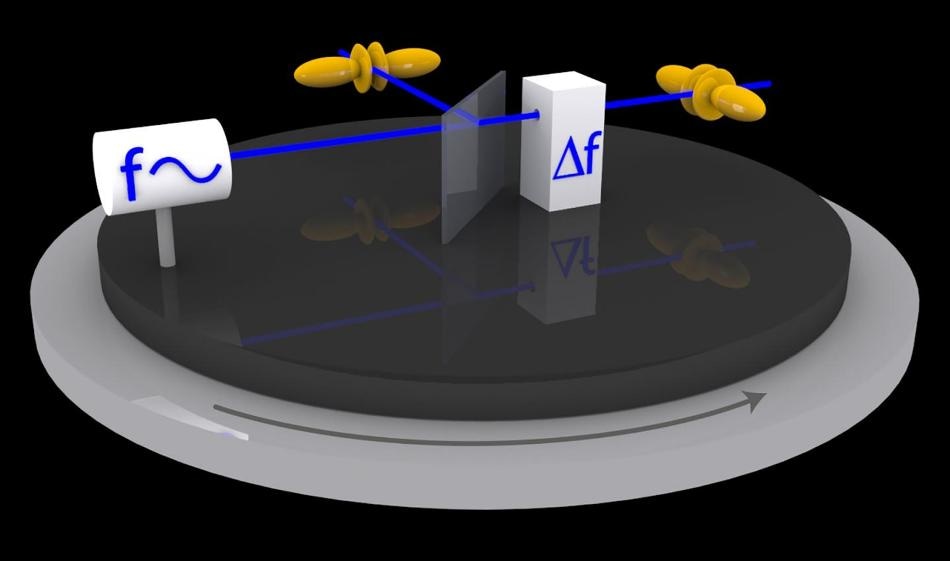Mar 14 2019
The hypothesis formulated by Einstein in his Special Theory of Relativity proved that the speed of light is the same all the time despite the given conditions. However, based on the theoretical models of quantum gravitation, it could be possible that this uniformity of space-time does not relate to particles.
 A tunable laser excites an extremely narrow-band resonance in a Yb+ ion of an atomic clock. The electron wave function of the ion’s excited state is marked in yellow. Two ions with wave functions that are oriented at right angles are interrogated by means of laser light with an adjustable frequency shift to measure a possible frequency difference. The whole experimental setup rotates together with the Earth once a day relative to the fixed stars. (Image credit: Physikalisch-Technische Bundesanstalt (PTB))
A tunable laser excites an extremely narrow-band resonance in a Yb+ ion of an atomic clock. The electron wave function of the ion’s excited state is marked in yellow. Two ions with wave functions that are oriented at right angles are interrogated by means of laser light with an adjustable frequency shift to measure a possible frequency difference. The whole experimental setup rotates together with the Earth once a day relative to the fixed stars. (Image credit: Physikalisch-Technische Bundesanstalt (PTB))
At the Physikalisch-Technische Bundesanstalt (PTB), physicists recently tested this hypothesis by applying a first long-standing comparison of two optical ytterbium clocks. Using these clocks, whose error totals to just one second in 10 billion years, there is the possibility of measuring even very tiny deviations of the movement of the electrons in ytterbium. However, when the clocks were oriented in a different way in space, the scientists were unable to detect any change.
This outcome has brought about an improvement in the existing limit for testing the space-time symmetry by means of experiments. The improvement here refers to a factor of 100. Furthermore, the scientists confirmed on the very small systematic measurement uncertainty of the optical ytterbium clocks of less than 4 × 10E−18. The research team made up of physicists from PTB and from the University of Delaware recently published its results in the present issue of Nature.
Since the olden times, this physics experiment has always been one of the most popular experiments: Way back in 1887, Michelson and Morley proved what Einstein later explained in the form of a theory. They used a rotating interferometer to compare the speed of light alongside two optical axes running vertically to each other. The very outcome of this experiment became one of the basic statements of Einstein’s Special Theory of Relativity: The speed of light remains the same in all directions of space.
The question that comes up now would focus on the possibility of applying this symmetry of space, named after Hendrik Antoon Lorentz, to the motion of material particles. Another possible question could actually ask whether there are any directions along which these particles passage faster or more slowly even though the energy continues to be the same. When specifically considering high energies of the particles, theoretical models of quantum gravitation expect a violation of the Lorentz symmetry.
To explore this question regarding high accuracy, an experiment has been presently performed using two atomic clocks. The resonance frequency of one Yb+ ion that is stored in a trap controls the frequencies of each of the atomic clocks. In the ground state, the electrons of the Yb+ ions have a spherically symmetric distribution, and in the excited state, they display a clearly elongated wave function and thus move chiefly along one spatial direction. A magnetic field applied within the clock determines the orientation of the wave function.
The field orientation was preferred to be roughly at right angles in the two clocks. The clocks are resolutely mounted in a laboratory and they are made to rotate together with the Earth once a day (more precisely: once in 23.9345 hours) relative to the fixed stars. If the speed of the electrons relied on the orientation in space, this would surely result in a frequency variance between the two atomic clocks that would occur occasionally, along with the Earth’s rotation. The frequencies of the Yb+ clocks were compared for over 1000 hours in order to distinguish such an effect clearly from any possible technical influences.
While the experiment was performed, no variation between the two clocks was observed for the accessible range of period durations from a few minutes up to 80 hours. For the theoretical interpretation and calculations in relation to the atomic structure of the Yb+ ion, PTB’s team collaborated with theoreticians from the University of Delaware (USA). The outcome of this teamwork drastically enhanced the limits set in 2015 by researchers from the University of California, Berkeley with Ca+ ions by a factor of 100.
Averaged over the overall measuring time, both clocks displayed a relative frequency deviation of less than 3 × 10E−18. This established the combined ambiguity of the clock that had earlier been estimated to be 4 × 10E−18. Additionally, it is a significant step in the categorization of optical atomic clocks at this level of accuracy. These clocks would potentially deviate from each other by one second only after approximately 10 billion years.